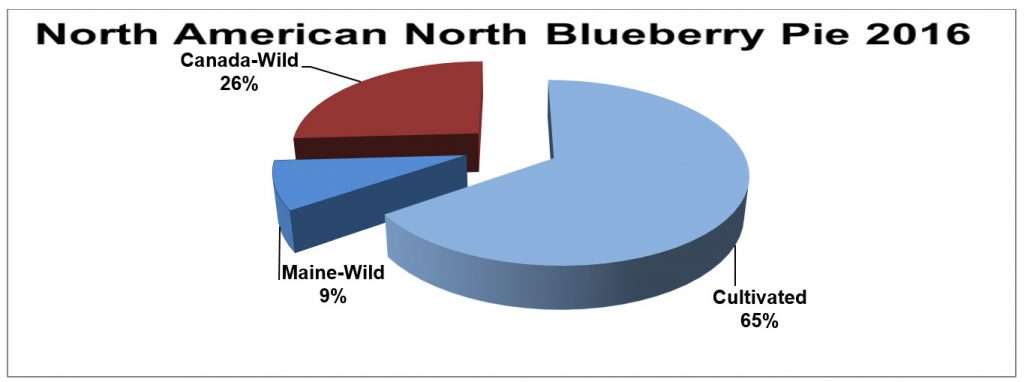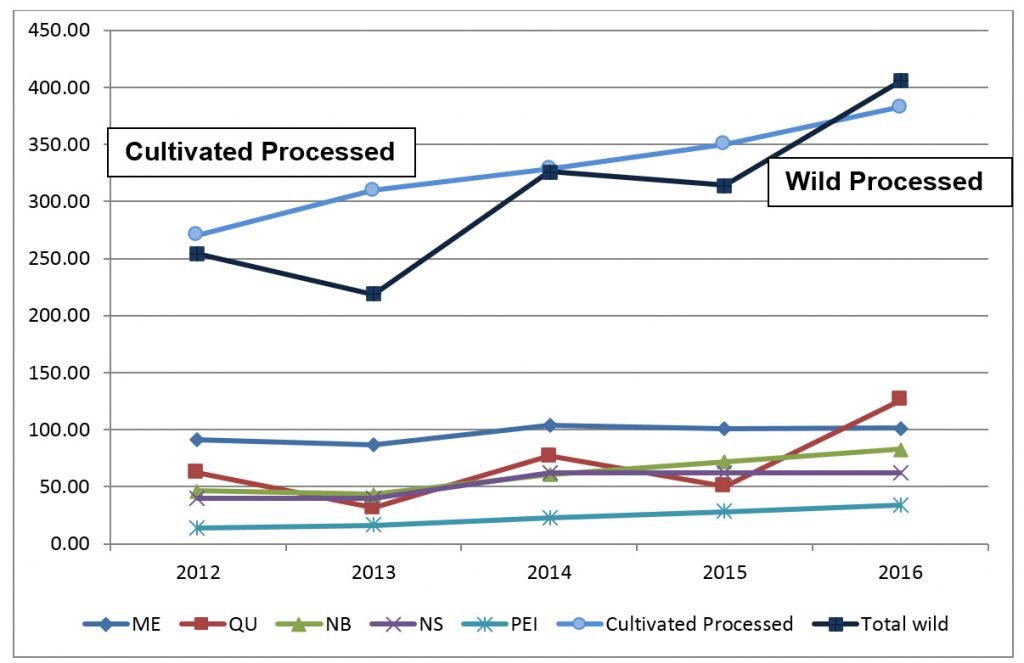Wild Blueberry Newsletter, July 2017
July 2017
Maine Wild Blueberry Crop 2016
The 2016 wild blueberry crop for Maine, as reported by the USDA National Agricultural Statistics Service on June 27, 2017, totaled 101.8 million pounds, which is equivalent to the 101.1 million pounds we had last year. Maine has had over 100 million pounds each year for the past three years. This is the third largest crop, after the 110.6 million pounds we had in 2000, and 104.4 million pounds we had in 2014. The Maine slice of the blueberry pie decreased from 10% to 9% of the total pie.
Production figure details for wild and cultivated blueberries in the United States may be found in the USDA Non-Citrus Fruit and Nut 2016 Summary, June 2017 (PDF).
Canadian Wild Blueberry Crop
 The wild blueberry crop in Canada was 303.7 million pounds, making this a record crop for Canada. Quebec had a 150% increase going from 50 million pounds in 2015 to 125.6 million pounds in 2016. New Brunswick increased from 62.5 to 82.8 million pounds and PEI from 28 to 34.3 million pounds. Nova Scotia’s crop was stable at 62 million pounds. The increase in Canadian production is attributed to good weather conditions and better management with the newly added acres coming into production. The Canadian slice of the pie increased from 21% to 26%. Much of this increase came from the bumper crop from Quebec in 2016. North America wild production has increased by 37% from 254 to 405 million pounds over the past five years.
The wild blueberry crop in Canada was 303.7 million pounds, making this a record crop for Canada. Quebec had a 150% increase going from 50 million pounds in 2015 to 125.6 million pounds in 2016. New Brunswick increased from 62.5 to 82.8 million pounds and PEI from 28 to 34.3 million pounds. Nova Scotia’s crop was stable at 62 million pounds. The increase in Canadian production is attributed to good weather conditions and better management with the newly added acres coming into production. The Canadian slice of the pie increased from 21% to 26%. Much of this increase came from the bumper crop from Quebec in 2016. North America wild production has increased by 37% from 254 to 405 million pounds over the past five years.
Total North American Blueberry crop in 2016 was 405.5 wild + 766.4 cultivated = 1171.9 million pounds.
Cultivated Blueberries

Total cultivated production in North America reported by the North American Blueberry Council for 2016 was 383.5 million pounds fresh and 382.9 million pounds processed for a total crop of 766.4 million pounds. Although an average of 50% cultivated blueberries is processed, those in the Pacific Northwest processed 75% of their crop. In the past eight years, the number of acres of cultivated blueberries has doubled, so more production is expected in future years. Cultivated processed production has shown a 30% increase from 270 to 383 million pounds over the past five years.
Wild Blueberry Industry to Receive Federal Support
See press release, below, from the Wild Blueberry Commission of Maine on their strategy to increase sales of Maine wild blueberries.
PRESS RELEASE
Maine’s Wild Blueberry Growers Build Demand in Face of Increasing Blueberry Supply
Back-to-Back Bumper Crops, a Weak Canadian Dollar, and Increased Cultivated Blueberry Production Pushes Maine’s Wild Blueberry Growers Toward Expanded Innovation, Increased Marketing, and a Request for Federal Support
PORTLAND, MAINE, July 6, 2017 — Maine’s 150-year-old Wild Blueberry industry is working to build demand for the state’s fruit while facing oversupply pressures and price competition resulting from a combination of factors, including a significant growth in cultivated blueberry production; several years of bumper Wild Blueberry crops in Maine and Canada; and a weak Canadian dollar that is giving Canadian Wild Blueberries a price advantage.
In response, Maine’s growers have launched a multi-tiered counter-offensive, which includes a more aggressive marketing campaign targeting consumers, food manufacturers, and food service channels, and a national public school food service initiative. Simultaneously, with support from Maine’s Congressional delegation and Maine Governor Paul LePage, the industry will receive up to $10 million for a “Bonus Buy” from the U.S. Department of Agriculture, approved today. The program is designed to support American agriculture and encourage domestic consumption by purchasing products and diverting them to programs such as the Child and Adult Care Food Program. The USDA program is not funded through taxpayer dollars.
“Maine’s wild blueberry industry has been an important part of Maine’s economy and culture for centuries. In recent years, however, the wild blueberry industry has faced increasing challenges from global oversupply of cultivated berries and steeply declining prices,” said Senators Collins and King and Representatives Pingree and Poliquin in a joint statement. “Earlier this year, we urged the USDA to provide relief to Maine growers through a bonus buy of surplus frozen wild blueberries, and we are pleased that the Department has agreed to take action. This investment to alleviate the supply issue, combined with the industry’s efforts to boost demand, will help create new opportunities for wild blueberry growers and support a bright future for this unique Maine crop.”
“Maine’s Wild Blueberry growers appreciate the USDA’s support and are optimistic about the future of the industry,” said Nancy McBrady, Executive Director of the Wild Blueberry Commission of Maine. The Bonus Buy helps to lessen the surplus and can help stabilize prices, she added.
“Maine Wild Blueberry growers are a resilient group, but global supply and pricing pressures are seriously impacting our business today, said Roy Allen, a fourth-generation Wild Blueberry grower and processor in Ellsworth. “The Bonus Buy will help alleviate some short-term pressures while we pursue a more aggressive long-term strategy. In the last three years, we’ve experienced an oversupply issue, but prior to that, it was not uncommon for our freezers to be virtually empty before the new harvest arrived.”
“Maine’s Wild Blueberry industry is beginning to embrace the enormous opportunity that bigger crops can deliver,” McBrady adds. “We are shifting our strategy to target more large-scale food service, restaurant chains, and manufacturing businesses, and because of our abundant supply, we are better positioned than ever.”
A differentiation strategy
The Wild Blueberry industry’s primary marketing strategy is to educate consumers about the power of wild foods and the significant advantages of Wild over cultivated blueberries.
“Wild Blueberries have more genetic diversity, a unique origin story, they deliver two times the antioxidants, more fiber, and have a more intense flavor than the watery cultivated ones,” McBrady stated. “We also conducted consumer research that showed that once people understand the taste, health, and ‘real foods’ advantages of Wild Blueberries, they are more likely to purchase them,” she continued. “It is our job to convey this powerful information to food manufactures and food service companies so that they incorporate Wild Blueberries into new products that consumers will enjoy. Our robust supply and ingredient versatility enables us to enter more product categories than ever before,” McBrady noted.
Kashi’s Wild Blueberry Waffles, Panera’s Wild Blueberry Scone, Stonyfield’s Wild Blueberry Yogurt, and Clif’s Wild Blueberry Almond Bar are a few examples of products now featuring and stating Wild Blueberries on their packaging.
The campaign also positions frozen Wild Blueberries as a leading superfruit ingredient in a growing smoothie craze, which constitutes the most significant way Americans consume frozen fruit. According to the Dole Food Company, home smoothie consumption accounted for 21 percent of all U.S. retail frozen fruit sales in 2006, and increased to 60 percent by 2014.
Results from the Wild Blueberry campaign include:
- Website traffic expanded fourfold since 2013. Last year, the Wild Blueberries website (Wild Blueberries of North America) received over 1 million visits up from 250,000 in 2013.
- Mentions in national mainstream media outlets nearly tripled, with 2,624 mentions in 2015 to 6,228 in 2016, with a total potential reach of 4.8 billion impressions in 2016
- Facebook likes have increased six-fold, from 50,000 in 2013 to 322,000 today.
- In early 2017, the industry launched a national school foodservice program aimed at increasing Wild Blueberries sales in public schools. Preliminary estimates show that in June 2017, Wild Blueberry sales exceeded 2.25 million lbs. in 22 states (up from 1.18 million lbs. in only 13 states for all of 2016).
- A significant increase in published scientific studies (The Health Benefits of Blue page, Wild Blueberries website) now documents the health benefits of Wild Blueberries. In 1998, 5 studies were published compared to 150 studies published in 2015. Many of these studies reveal groundbreaking science about brain health, gut health, disease fighting properties, and antioxidant capacity of Wild Blueberries.
“American consumers are demanding healthier food and pure ingredients that are closer to nature,” said McBrady. “Given the market forces at work and our healthy supply of berries, we are working aggressively to tell our unique heritage, taste, and health story. We have seen that when consumers and food manufacturers understand the difference between Wild and cultivated blueberries, they almost always opt for Wild because it offers a more delicious taste and denser nutritional value. Through our commitment to better and greater outreach to key customer groups, I’m confident that Maine’s Wild Blueberry industry has a bright future.”
About the Wild Blueberry Commission of Maine
The Wild Blueberry Commission of Maine was established to promote the ongoing prosperity of the Maine Wild Blueberry industry. It works on behalf of Maine’s 500+ growers and processors of Wild Blueberries in the areas of research and education, promotion, and policy. For more information visit the Wild Blueberries website.
Sincerely,

David E. Yarborough
Extension Blueberry Specialist
Wild blueberry fact sheets, past newsletters, contacts, resource links, calendar of events, and more can be found on the Cooperative Extension’s Maine Wild Blueberries website.
Information in this publication is provided purely for educational purposes. No responsibility is assumed for any problems associated with the use of products or services mentioned. No endorsement of products or companies is intended, nor is criticism of unnamed products or companies implied.
© 2017
Call 800.287.0274 (in Maine), or 207.581.3188, for information on publications and program offerings from University of Maine Cooperative Extension, or visit extension.umaine.edu.
The University of Maine is an EEO/AA employer, and does not discriminate on the grounds of race, color, religion, sex, sexual orientation, transgender status, gender expression, national origin, citizenship status, age, disability, genetic information or veteran’s status in employment, education, and all other programs and activities. The following person has been designated to handle inquiries regarding non-discrimination policies: Director of Equal Opportunity, 101 Boudreau Hall, University of Maine, Orono, ME 04469-5754, 207.581.1226, TTY 711 (Maine Relay System).

